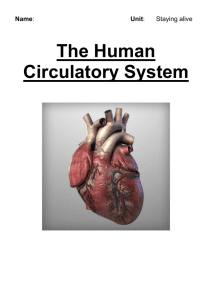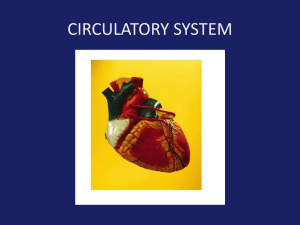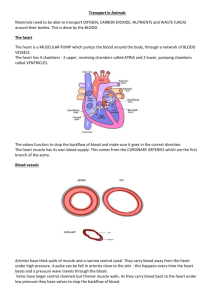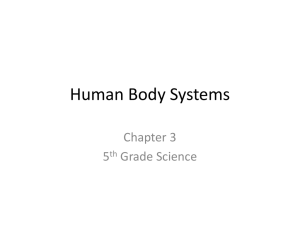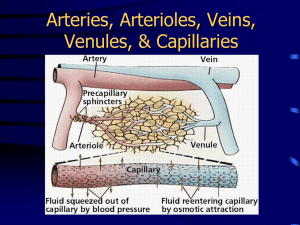the summary - The Circulatory System
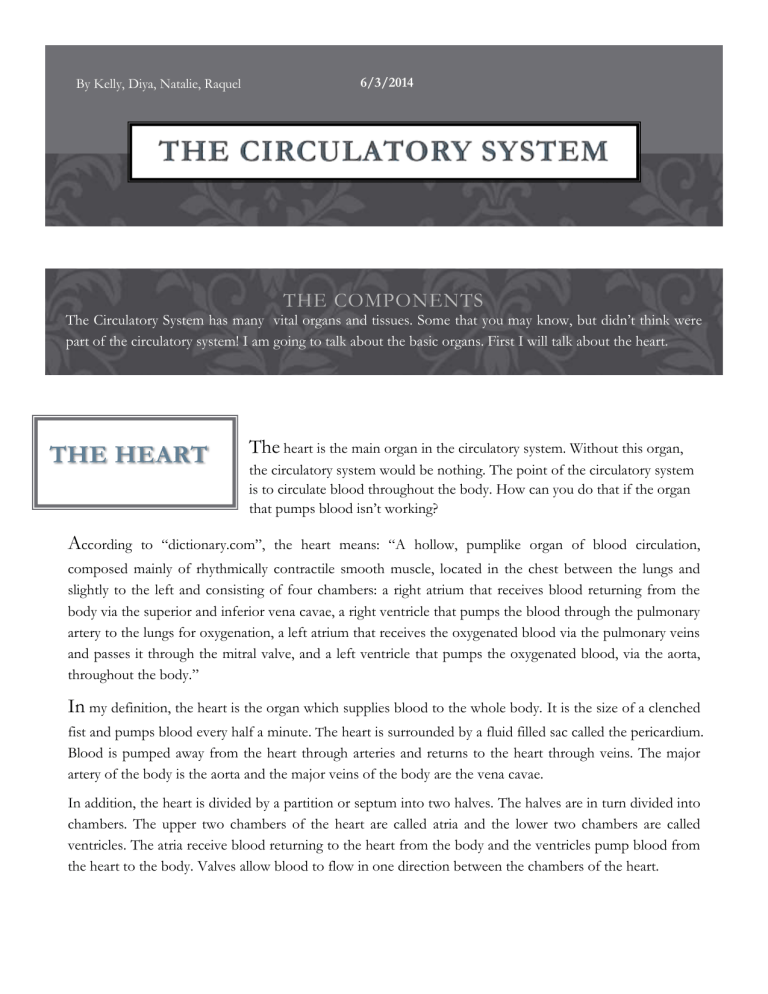
By Kelly, Diya, Natalie, Raquel 6/3/2014
THE COMPONENTS
The Circulatory System has many vital organs and tissues. Some that you may know, but didn’t think were part of the circulatory system! I am going to talk about the basic organs. First I will talk about the heart.
THE HEART
The heart is the main organ in the circulatory system. Without this organ, the circulatory system would be nothing. The point of the circulatory system is to circulate blood throughout the body. How can you do that if the organ that pumps blood isn’t working?
A ccording to “dictionary.com”, the heart means: “A hollow, pumplike organ of blood circulation, composed mainly of rhythmically contractile smooth muscle, located in the chest between the lungs and slightly to the left and consisting of four chambers: a right atrium that receives blood returning from the body via the superior and inferior vena cavae, a right ventricle that pumps the blood through the pulmonary artery to the lungs for oxygenation, a left atrium that receives the oxygenated blood via the pulmonary veins and passes it through the mitral valve, and a left ventricle that pumps the oxygenated blood, via the aorta, throughout the body.”
In
my definition, the heart is the organ which supplies blood to the whole body. It is the size of a clenched fist and pumps blood every half a minute. T he heart is surrounded by a fluid filled sac called the pericardium.
Blood is pumped away from the heart through arteries and returns to the heart through veins. The major artery of the body is the aorta and the major veins of the body are the vena cavae.
In addition, the heart is divided by a partition or septum into two halves. The halves are in turn divided into chambers. The upper two chambers of the heart are called atria and the lower two chambers are called ventricles. The atria receive blood returning to the heart from the body and the ventricles pump blood from the heart to the body. Valves allow blood to flow in one direction between the chambers of the heart.
TISSUES
Blood and blood vessels.
BLOOD
Th e walls of arteries, veins, and capillaries are very different in structure. In all three, the vessel wall surrounds a hollow center
VESSELS
through which the blood flows. The walls of both arteries and veins are composed of three layers, but they differ in thickness. The inner and middle layers of arteries are thicker than those of veins. This makes arteries more capable of expanding when blood surges through them from the beating heart. The walls of veins are more flexible than artery walls. This allows skeletal muscles to contract against them, squeezing the blood along as it returns to the heart. One-way valves in the walls of veins keep blood flowing in one direction. The walls of capillaries are only one cell thick. Of all the blood vessels, only capillaries have walls thin enough to allow the exchange of materials between cells and the blood. Blood pressure is the pressure of blood against the wall of an artery. Blood pressure originates when the ventricles contract during the heartbeat. It is strongest in the aorta and decreases as blood moves through progressively smaller arteries.
A sphygmomanometer is an instrument that measures blood pressure in millimeters of mercury. Blood pressure normally increases with age.
More information in brochures.
BLOOD
B loo d is composed of plasma (liquid portion) and blood cells. Plasma, which is about 91.5 percent water, carries blood cells and helps conduct heat. The three types of cells in blood are red blood cells, white blood cells
(leukocytes), and platelets. More than 99 percent of all the blood cells are red blood cells. They contain hemoglobin, a red pigment that carries oxygen, and each red cell has about 280 million hemoglobin molecules. White blood cells fight diseases in organisms by destroying them or by producing antibodies. Platelets job is the clotting of the blood.
IS EVERY THING NESSCARY
Every part of the circulatory system is vital because each part of the circulatory system helps another system.
Artery: Vessel that transports blood away from the heart.
Atherosclerosis: Condition in which fatty material such as cholesterol accumulates on artery walls forming plaque that obstructs blood flow.
Atrium: Receiving chamber of the heart.
Capillary: Vessel that connects artery to vein.
Diastole: Period of relaxation and expansion of the heart when its chambers fill with blood.
Hormones: Chemical messengers that regulate body functions.
Hypertension: High blood pressure.
Sphygmomanometer: Instrument that measures blood pressure in millimeters of mercury.
Systole: Rhythmic contraction of the heat.
Vein: Vessel that transports blood to the heart.
Ventricle: Pumping chamber of the heart.
QUESTIONS TO THINK ABOUT, AND ANSWERS TOO.
1.
Why are capillaries important within your body?
The capillaries help exchange carbon dioxide and cell waste with blood’s nutrients and cell waste.
2.
What type of tissue are blood vessels.
They are connective and muscular.
3.
Why can AB+ give blood to everyone, but can receive only AB+?
AB+ has A antigens, so it can’t give to B. AB+ has B antigens so it can’t give to A. O has no antigens so AB+ can’t give to O.
4.
What is plasma made out of? How does it help cells?
Plasma is made out of 90% water, minerals, sugars, salts, fatty acids hormones, enzymes, vitamin, medications, and amino acids. These substances help the cell to be energized, and help heal cells.
5.
What is the most essential organ of the human body? Why?
The heart pumps blood and nutrients throughout the body.





